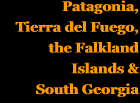Patagonian pacifics, and an early dieselisation
Main line steam engines
Whilst the arrival of the new locos was awaited a variety of second-hand locos found their way onto all three Patagonian lines. In many cases the older machines were intended only for use during the construction works, but several of them found their lives extended.
The 1926 US Dept. of Commerce report (1) lists the San Antonio railway as having 12 pacifics (as mentioned above), 5 Baldwin 4-4-0s, 2 Beyer Peacock 2-6-0s (1890), 1 Baldwin 4-8-2 (1924) and 2 Tubize 0-6-0 shunters of 1889.
Number of locomotives
|
Wheel arrangement
|
Weight empty
Tonnes
|
Builder
|
12
|
4-6-2
|
55.0
|
Maffei (1910)
|
5
|
4-4-0
|
36.8
|
Baldwin
|
2
|
2-6-0
|
40.5
|
Beyer, Peacock
|
1
|
4-8-2 *
|
93.0
|
Baldwin (1924)
|
2
|
0-6-0
|
37.0
|
Tubize (1889)
|
A more detailed list of individual locos, drawn from Reg Carter's comprehensive volume (2) and from the 1945 FCE working timetable, is in an appendix page.
1 The pacifics
The principal motive power on all three FCE lines comprised the class 12M pacifics dating from 1910. These were built in several batches by Maffei in Germany (Nos. 330-342?), Cockerill in Belgium (360-364?), and Haine St. Pierrre in France (350???). A number of them worked the Bariloche line whilst smaller groups went further south: nos. 354-5, 362, and 365 were at Comodoro Rivadavia for the line to Sarmiento, and nos. 350-2 and 361 were at Puerto Deseado.
The Maffei pacifics mainly concentrated on the San Antonio to Nahuel Huapi (Bariloche) line had Belpaire fireboxes in contrast to the round-topped boxes on the Cockerill and Haine St. Pierre locos. The photo below is almost certainly an official photo of ome kind, and probably taken when the loco was brand new as its carries an early pattern number plate from before the FCE renumbering (11).
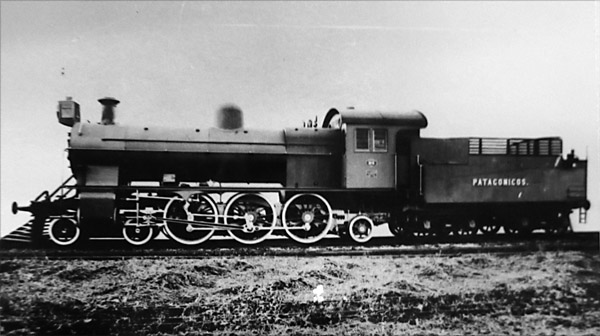
A similar loco at the end of its life, lying abandoned and with its dome removed (11). It looks as though the cab windows have been combined, perhaps to make it easier for the crew to look out, and there is certainly a bigger tender with cast steel bogies.
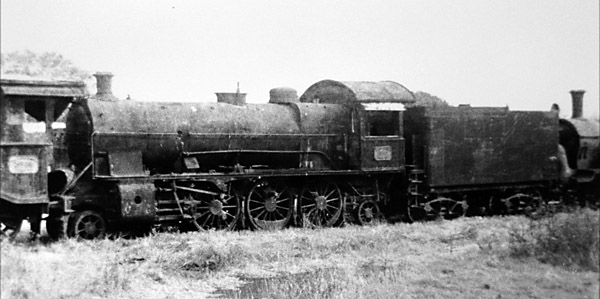
2 The Baldwin 2-10-2s.
For heavy haulage a pair of 2-10-2s were purchased from Baldwin in 1926, nos. 500 and 501, later given the class designation 14A. These were commonly used for passenger or ‘mixto’ trains to Bariloche.
An official photo of one of the BLW 2-10-2s (11).
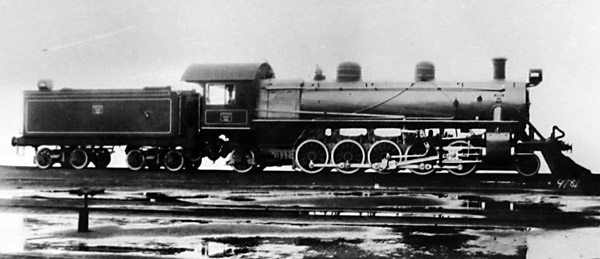
A 2-10-2 on a train, location unknown (11). It looks as though this is indeed a passenger train, albeit with a couple of vans at the front end.
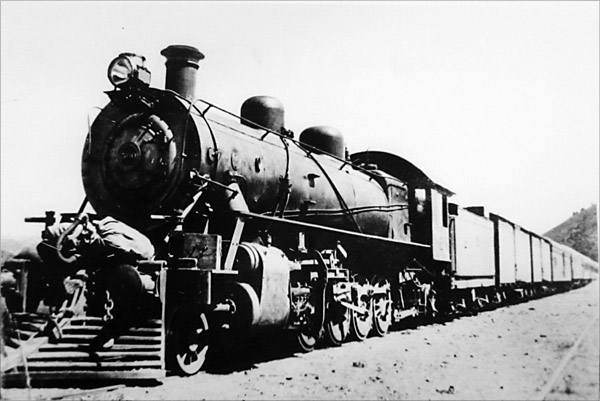
A derelict 2-10-2 (11). Apart from the big oil tank in the tender, the obvious changes during its life have included a larger smokebox door with British style centre locking, and the loss of the rear feed pipes from the sand dome.
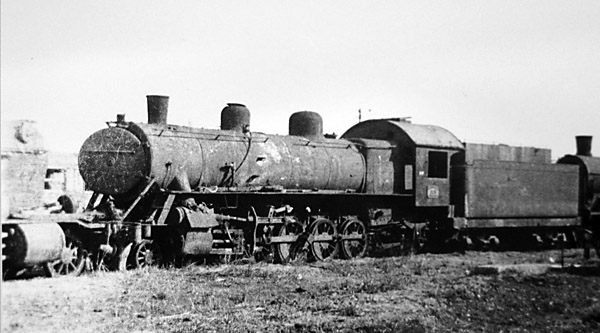
3 Other locos
This very early photo shows ex Central Argentine Railway Beyer, Peacock class 7C 2-6-0, number 63 in the first FCE numbering system. This loco had been FCCA number 426, and became FCE 381 after the renumbering. On the opposite side of the buffer-beam from the number 63 is the SA circle logo indicating a loco allocated to the San Antonio to the Lago Nahuel Huapi line.
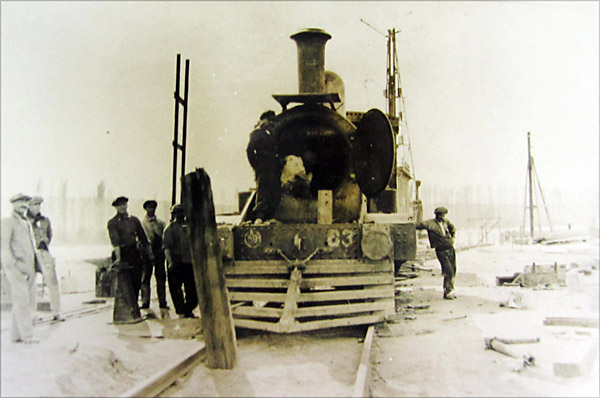
This not very good photo was found in the San Antonio Oeste museum and shows one of the Beyer Peacock 2-6-0 that were sent to the line for its opening. The Heinz family are standing on the running plate. (2B)
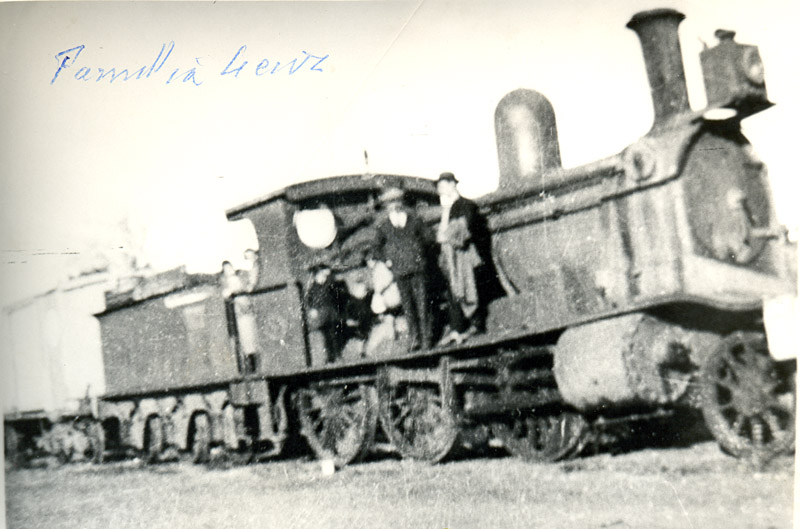
Also found in the museum was this view of one of the Tubize 0-6-0s which had come to grief; the circumstances are unknown.
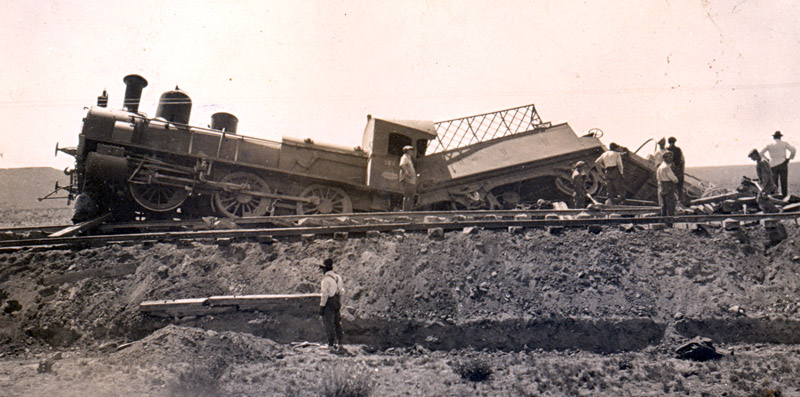
A mystery loco
A single large 4-8-2 was built by Baldwin in 1924 for the FCE. This is a puzzle because it was too heavy to work on any of the Patagonian lines, which were the only FCE broad gauge routes at that time. The suspicion is that it was built speculatively by Baldwin to try and break into the Argentine state railways market. It was tested at on the Oeste route from Buenos Aires to Mendoza but thereafter it seems to have lain out of use, eventually succumbing to fire damage when its fuel tank caught alight. There are various rumours that it may originally have been erected at San Antonio Oeste works, or even been tested on the Comodoro Rivadavia route, but these seem unlikely to have occurred.
The Baldwin 4-8-2 known as 'el big bus' is seen in a BLW official photo before shipment to Argentina.
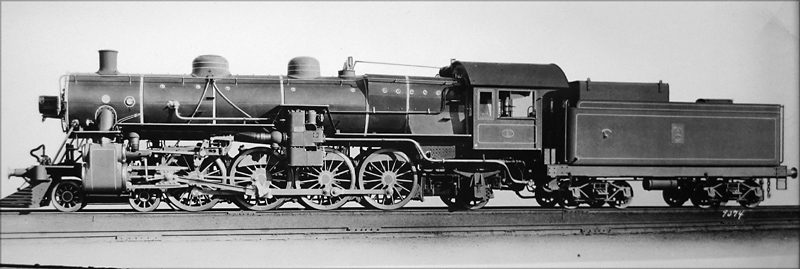
The image below seems to show the locomotive in service. No obvious differences from the builder's photo above can be detected.
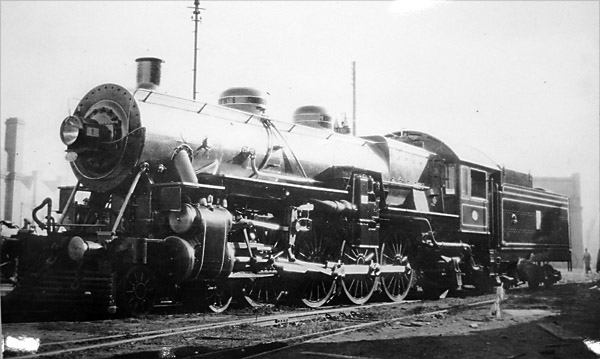
Locos initially used 'Cardiff' steam coal imported through San Antonio or, later, Viedma, but eventually most locos were converted to burn oil.
San Antonio works
In 1909 when construction began, the FC del Estado were planning a network of routes from San Antonio west and south. San Antonio was chosen as the main workshop site for this new system and a major facility was built. Of course the network never materialised as planned and even the later narrow gauge to Esquel declared independence and built its own works at El Maiten. The workshops are now largely empty though there are a large number of vehicles outside in the yards.
Classes used in later years
Unlike the other FCE Patagonian broad gauge routes the San Antonio line was eventually linked up via Viedma and Carmen de Patagones to the rest of the Argentinian broad gauge. As such it had heavier traffic, and its loco stock could more easily be supplemented from elsewhere. This was especially true after 1948 when it came under the same management as the FC Sud as the FC General Roca.
The ex-FC Sud class 11C and 15B 4-8-0s, and the class 11D 2-8-0s saw service on the line.
The works shunter fron San Antonio Oeste No. 2535 has been sent out to assist in dealing with a derailment. This view shows how it is fully equipped to operate bunker first on the main line and has a strange upward and outward extension to its bunker. (2B)
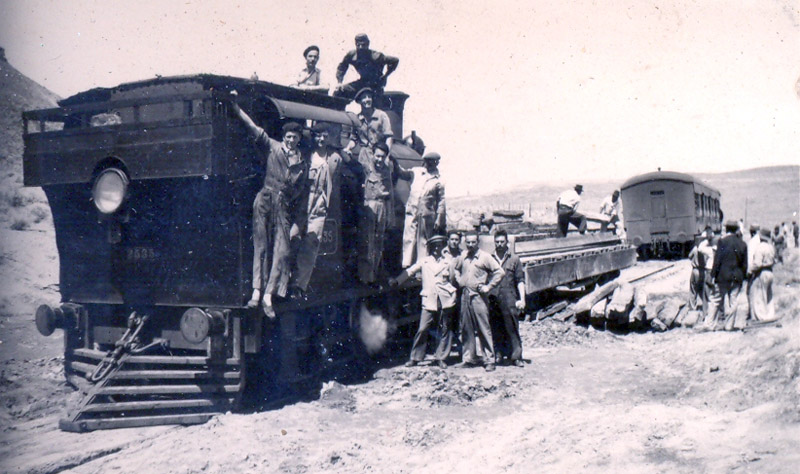
An ex- FC Roca 0-6-0 saddle tank still lies in San Antonio works yard in 2000.
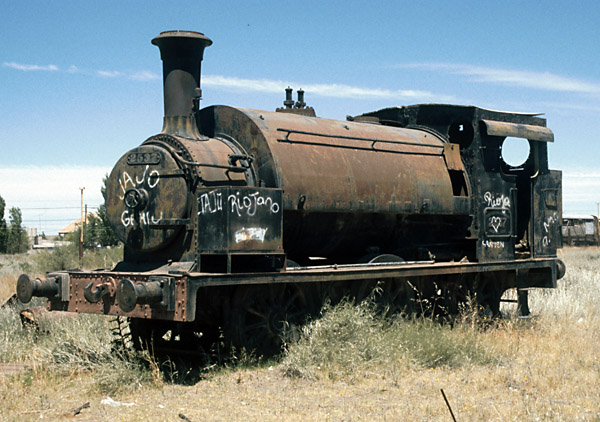
The 1931 explosion
A notable though tragic event in the line's steam history occurred in 1931 when the firebox crown on a Maffei pacific. no.337, collapsed out west of San Antonio near Mancha Blanca. The event was recorded in a series of photos preserved by the footplatemen's union - La Fraternidad - as a salutary lesson. The photos are now on display in San Antonio town museum.
The Maffei batch of pacifics are easily identified by their Belpaire firboxes. Whether this is actually no. 337 or merely just an example of the class is not clear.
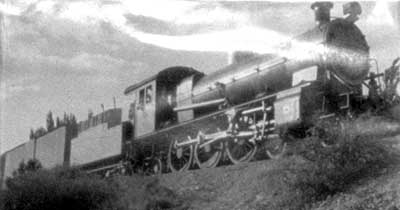
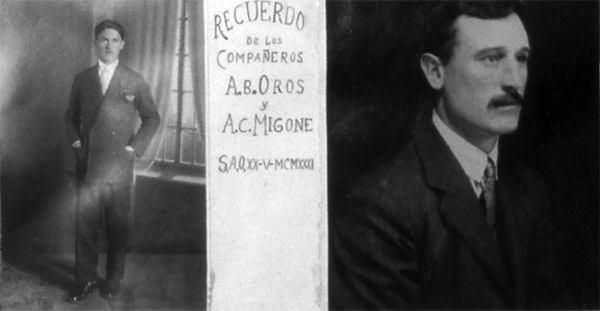
The driver and fireman, Señors Oros & Migone are commemorated in the photos above, whilst the firebox crown can be seen below.
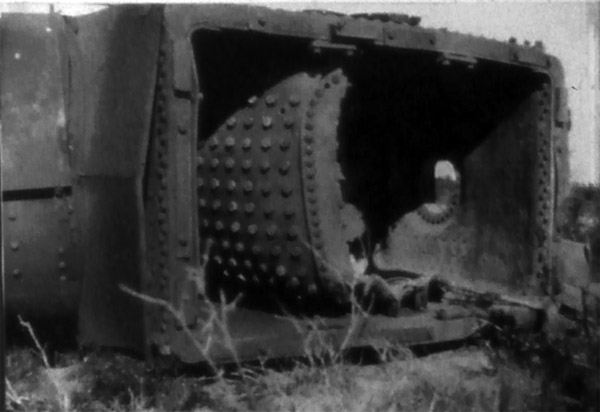
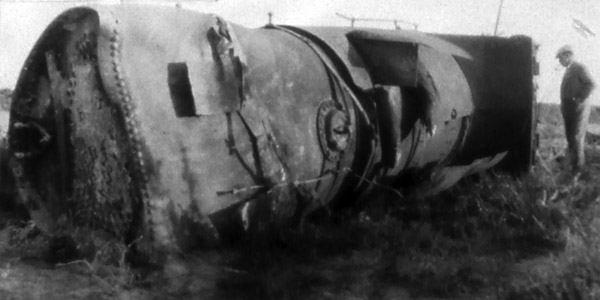
The boiler is supposed to have landed many yards away, leaving the loco chassis looking as in the picture below!
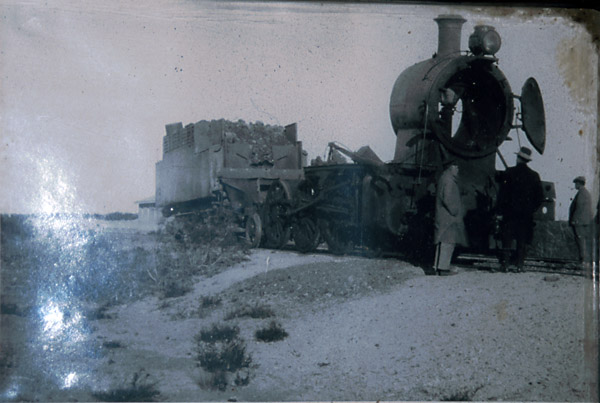
The Neneo Ruca collision, 1939
There was a head-on collision between two trains in the Neneo Ruca gorge, in 1939. The damage was such that at least one of the locomotives was totally destroyed though both locos seem to have been rebuilt and eventually returned to service. The collision was between Maffei pacific 341 on a freight from Bariloche, and 2-10-2 no. 500 on a westbound passenger train. A good deal more information about this accident has recently come to light, thanks to a press article containing the recollections of a retired railwayman. This article is reproduced in an appendix page.
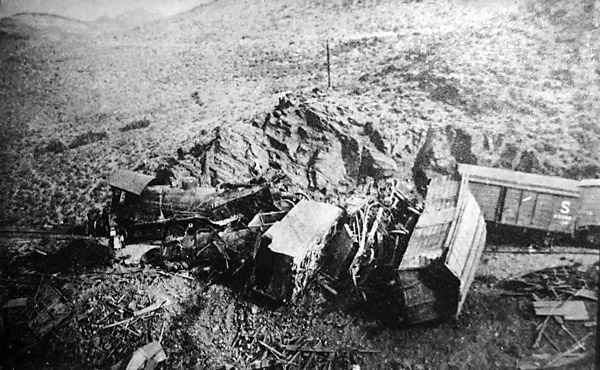
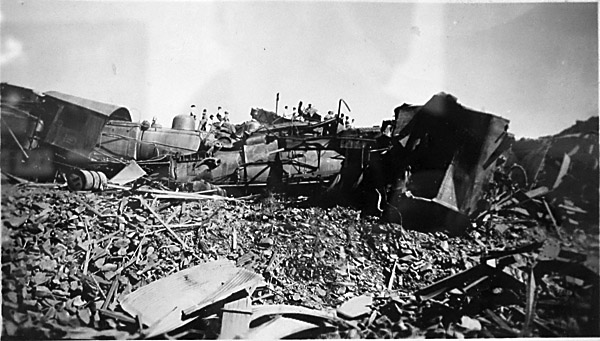
Ganz railcars
In 1935 the FFCC del Estado decided to purchase 34 diesel rail coaches from Ganz of Hungary. These were of a variety of designs, mostly for metre gauge use, though two were for standard gauge and three for the Patagonian broad gauge. The latter were delivered each in two parts for ease of unloading at the Patagonian ports (9). Car no. CM3 was delivered for use on the Bariloche line between Viedma and Valcheta whilst the other two went further south. It seems to have been dismantled around 1960.
The photo shows railcar CM3 at the workshops in San Antonio Oeste (10).
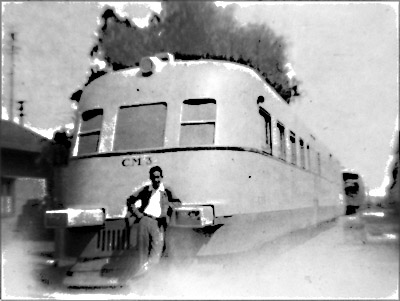
Trens Bariloche
In 1937 a second series of Ganz diesel multiple units were introduced to run a prestigious service carrying tourists to Bariloche. These were actually classified as class TB (Tren Bariloche). There were two three-car sets with a maximum speed of 110kmph (roughly 70mph). The power cars were numbered CM10/11 and CM20/21. Each set could carry 44 first class and 88 second class passengers. They ran on the Bariloche line for ten years but were transferred elsewhere after the nationalisation and re-organisation of 1948 (9).
One of the TBs is seen on a trial trip in the Cañadon de Viuda. (Photo by a Ganz official)
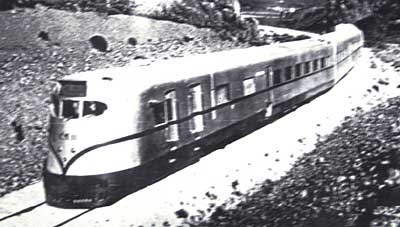
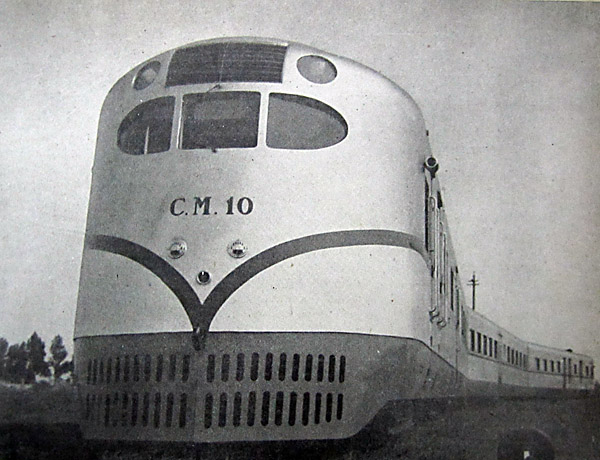
A new depot was built at Viedma for the diesel sets, beneath the embankment up to the Rio Negro bridge.
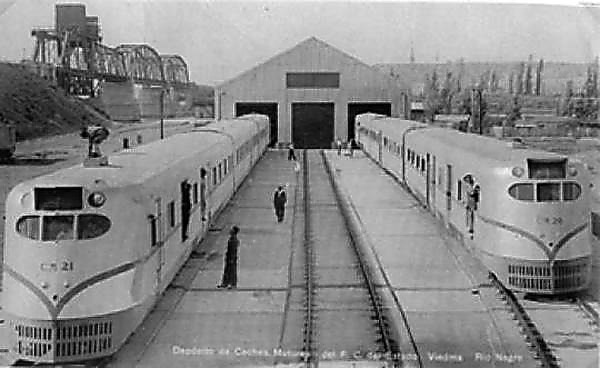
Early diesel locomotives
The San Antonio Oeste to Bariloche line was dieselised early on in about 1953, not surprising given the arid nature of the countryside. The earliest diesels were the very distinctive Baldwin products before they dropped out of the competition with GM (EMD) and GE. There were also a number of Baldwin-licensed Cockerill machines from Belgium. The two lines further south were never dieselised. The low level of traffic did not justify the necessary investment. On these routes the pacifics survived until closure.
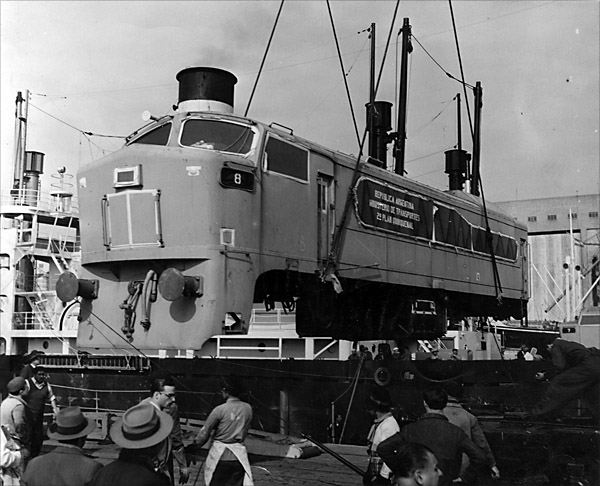
A Baldwin is offloaded from the ship bringing it to Argentina.
Baldwin RF615Es (DE121s)
50 of these 'shark-nosed' units were ordered, and delivered in 1953-4. The locos were of 1500hp and were built in 1953-4, initially for the Neuquen and Bariloche lines. Originally they were numbered from 5001 upwards, though later renumbered into the 7001 series. Overall dimensions were 14.789m length, 4.000m height, and 3.096m width. Weight in service was 105 tonnes. No 7044 is still in use as works pilot at Talleres Maldonado, and no 7037 is being restored by the Ferroclub de la Seda de Remedios de Escalada.
One of the shark-nosed Baldwins is seen in this photo from the national railway museum in Buenos Aires. The location is the south end of Patagones station and the photo by Marcelo Arcas.
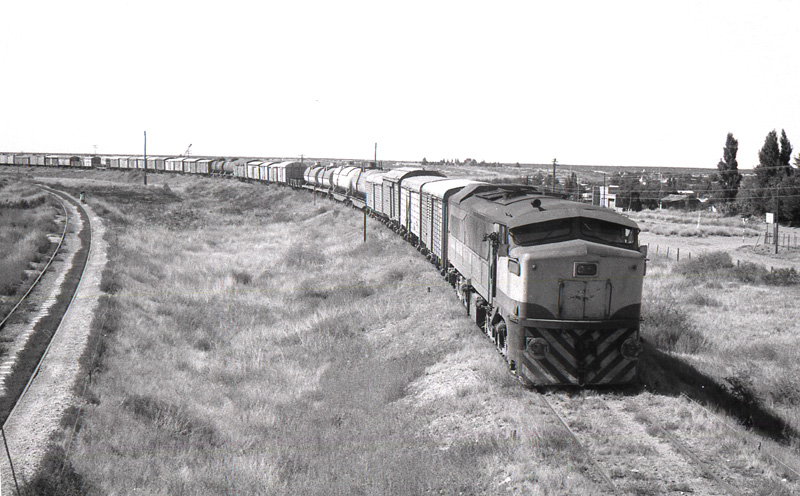
Another 1972 picture by Marcelo Arcas shows Baldwin 7041 at Bariloche. The forward rake of the front end which gave rise to the 'shark-nose' nickname is very obvious.
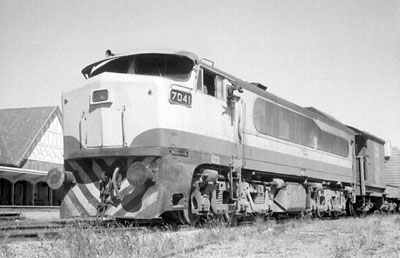
Cockerill-Ougree 2R616E
Locos to a Baldwin-Lima-Hamilton design were built in Belgium by Cockerill in 1959. These were nos 7052-7101. They weighed 102 tonnes in service and produced 1500hp. Overall dimensions were 17.685m length, 4.252m height, and 3.000m width. Originally they had been built for suburban services but after 1963 they moved out to general use, particularly from Bahia Blanca.
The photo below shows a Cockerill diesel (and a newer GT22) at Bariloche shed in February 1972 (8).
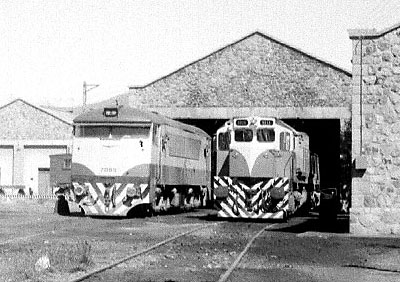
Current diesel power
Tren Patagonico SEFEPA, the present franchise holder running the line, has a small but eclectic collection of diesel locomotives.
Alco /Euskalduna DL500S
SEFEPA purchased nos 2129 and 2176 from RENFE in Spain. They had been built in Spain by Euskalduna but to an Alco design. Whilst both locos are out of use, there have been suggestions in the past that 2129 was to be renovated. Click here to see a drawing by Alejandro Moscaro of these locos.
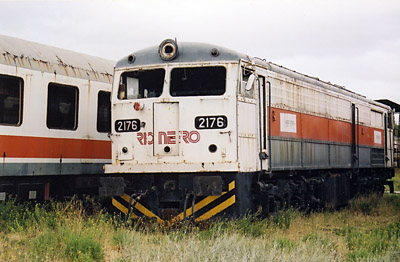
2176 lies derelict at San Antonio works (7).
Hood units are of varied designs:
MLW/Alco RSD35
6411, a 1200hp Co-Co built in 1963. This one of a batch of 55 built by the Montreal Loco Works for the Ferrocarril San Martin, numbered 6411 -6480. They weigh 80 tonnes. Overall dimensions are 13.818m length, 3.870m height, 2.943m width.
Alco RSD16
8238 is a 1800hp road switcher built in 1958 for the Ferrocarril General Mitre. 55 of these were built in the number series 8226-8280. They weigh 108 tonnes in service. Overall dimensions are 16.002m long, 4.445m high, and 3.089m wide.
EMD GT22CWs
9033, 9070 and 9073 are GT22CWs from EMD/Astarsa, built in the 1980s.
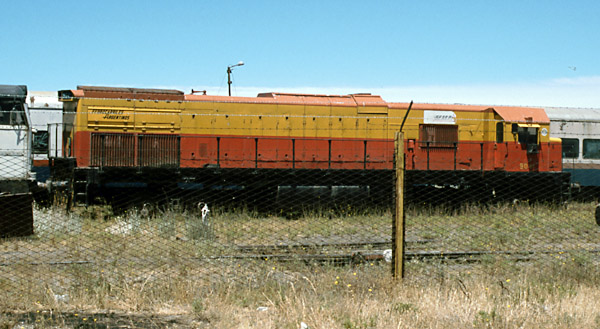
This is one of Tren Patagonico's GT22CWs in an earlier livery.
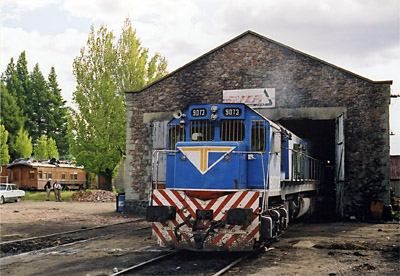
GT22CW no 9073 at Bariloche loco shed (7)
EMD G22CWs
7904, 7910 and 7920 are G22CWs from the General Urquiza system, regauged by Ferrosur Roca at Olavarria workshops. Click here to see a drawing by Alejandro Moscaro of these locos.
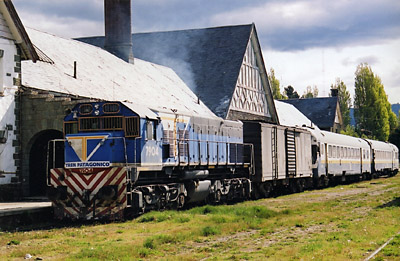
G22CU no 7904 at Bariloche with a train made up of de-engined Fiat railcars. (7)
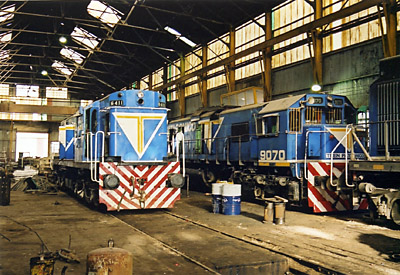
Three different types of diesel in the workshops at San Antonio. On the left is Alco RSD35 no 6411; in the centre EMD GT22CW no 9070, and on the right Alco RSD16 no 8238. (7)
A de-engined Fiat railcar set has been used in recent years, particularly for a shorter distance train service between Ing. Jacobacci and Bariloche, the parallel roads being particularly poor along this section. This unit has now received Scania replacement engines and is expected to operate this service independently in future.
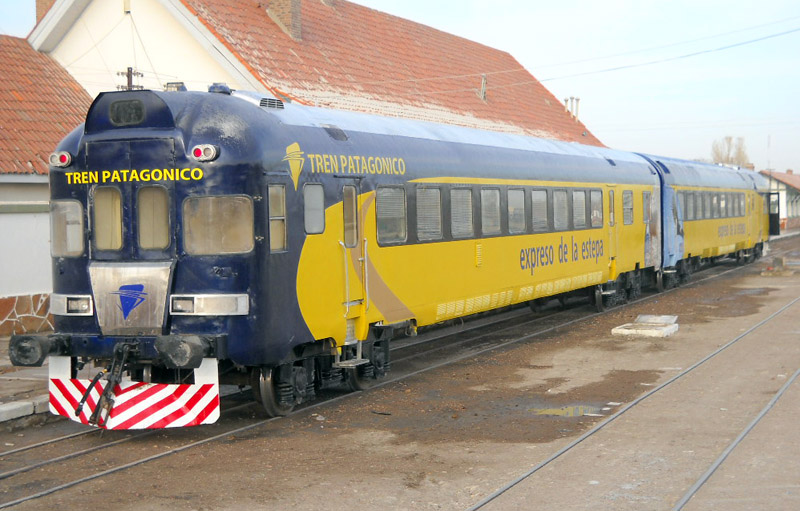
One of the Meinfesa class 319-3 diesels bought from Spain by SOFSE and hired out to users such as Tren Patagónico, in this case hauling a limestone train.
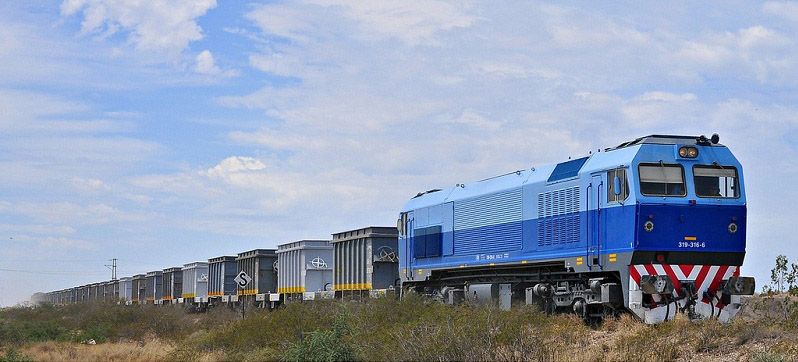
Tourist train from Bariloche
For several years a tourist service from Bariloche was attempted, hauled by an ex Buenos Ayres al Pacifico 2-8-0 that had been built by North British. The operation was an attempt by Río Negro province to compete with La Trochita from Esquel, but suffered from a lack of commitment by relevant parties. The locomotive was then stored in the goods shed at Bariloche for several years, but more recently, in 2016, has been moved to Ing. Jacobacci for work to be undertaken to return it to operating condition.
Work was reported as currently being undertaken during 2021 by G & G Metalica. (12)
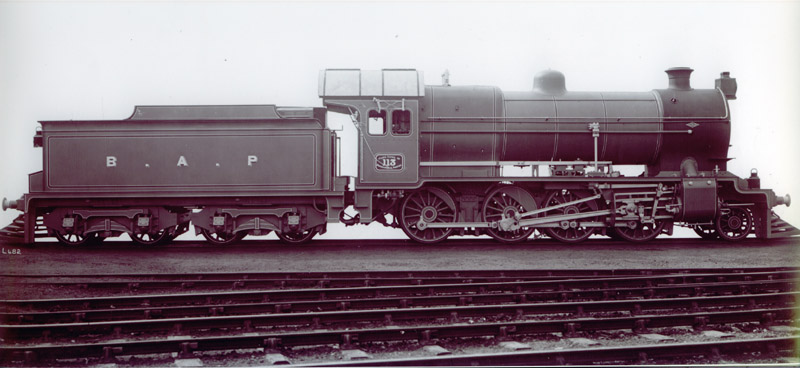
References:
1 Railways of South America: Part I: Argentina. (William Rodney Long (& George S. Brady?), U.S. Bureau of Foreign and Domestic Commerce - Trade Promotion Series No. 32, U.S. Government Printing Office, Washington D.C. 1926.
2 Railways of Argentina (List of all known locos). Reg Carter. Duplicated, spiral bound. 46 Mill St., Kingston upon Thames, Surrey, KT1 2RF. UK.
2A El 'big bus', web page, author unknown.
3 1912 report
4 Railways of South America: Part I: Argentina. (William Rodney Long (& George S. Brady?), U.S. Bureau of Foreign and Domestic Commerce - Trade Promotion Series No. 32, U.S. Government Printing Office, Washington D.C. 1926.
5 Libro Nro. 1 - Clasificador y Tarifas Basicas uniformes Published by the Secretaria de Transportes de la Nacion - Ferrocarriles Nacionales February 1st. 1949, second update June 1st 1952. Another update was published in 1955.
6 Chris Capewell, who is a specialist in rail cranes, has written with his provisional suggestions: The larger crane, it is surmised, might be from one of three orders - from H. Wilson of Birkenhead, 30ton capacity for BAPR in 1910-2, or 35ton capacity for BAGS around 1912, or from Cowans Sheldon 40 ton capacity for BAGS, nos 4464-8 in 1925. All of these were mounted on 10 wheeled chassis but there were differences in the number of engines for raising and slewing.
7 The recent photos of Tren Patagonico diesel locos were very kindly provided by Robert Humm.
8 Marcelo Arcas has kindly provided the black and white photos of diesel locos and a coach taken in 1972. Marcelo runs the Rumbo al Sud internet magazine devoted to the railways south of Buenos Aires and particularly the FCS and its successor the FC General Roca.
9 Web-pages on the subject of the Ganz diesel railcars and multiple units are available at: <http://www.geocities.com/matrodante/GPguerra.htm> and <http://www.geocities.com/juanca010/ganz22.htm>. Link currently (January 2011) unavailable
10 Photo by courtesy of Señor Diego de Bunder of Puerto Madryn, whose grandfather's house was adjacent to the photo location.
11 Photos reproduced by kind permission of the Fundación Museo Ferroviario in Buenos Aires.
12 Facebook page, Máquinas a vapor de G y G Metalmecánica, 10/2/21.
18-3-2021
|

